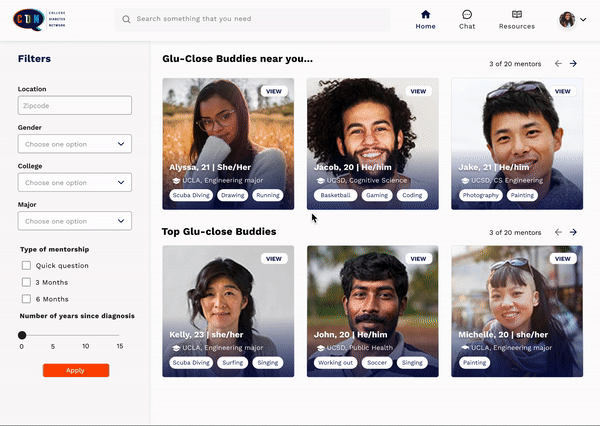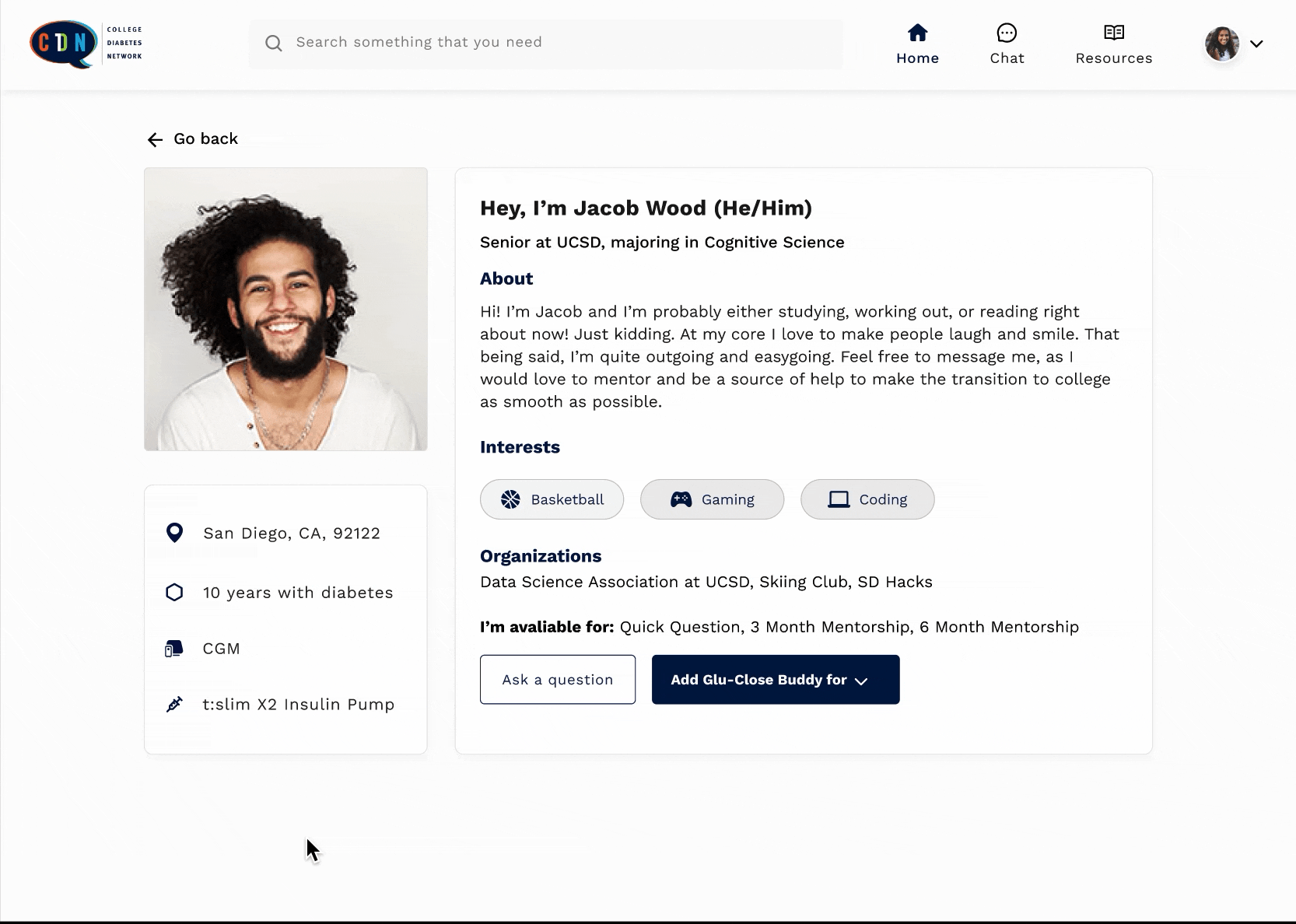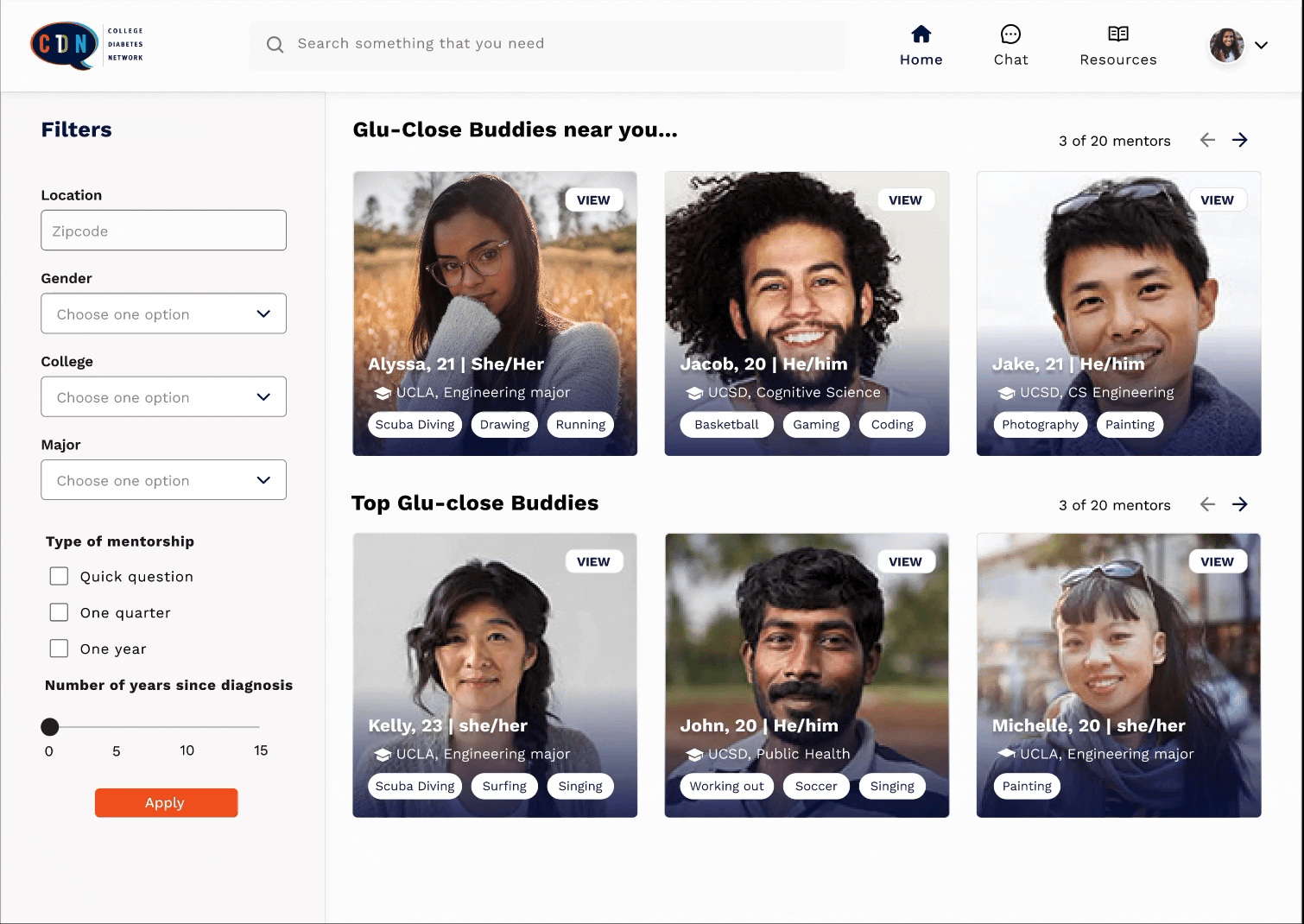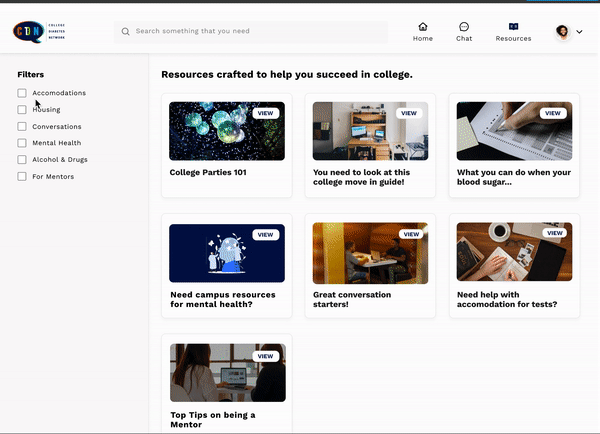Glu-Close Buddies
My Role: User Research Lead & UX/UI Designer (1 of 5)
The transition from high school to college is already a difficult one, and it’s significantly harder with a chronic illness such as Type 1 Diabetes. The College Diabetes Network (CDN) is an organization that aims to help young people with diabetes transition to college and the workforce by providing them with resources and connecting them to peer support.
CDN tasked our team with finding a new way to reach and deliver their high-quality content to prospective college students with Type 1 (T1) diabetes. Currently, CDN has “Off To College” guides for students and parents; however, not many people download these guides off the website, which limits their impact. After talking to CDN’s Mission and Community Director, CDN’s optimal outcome was a 2.0 version of the guide that could reach more prospective and current college students.
PROBLEM STATEMENT
How might we ease the transition from high school to college for prospective Type 1 Diabetes students?
User Research: Searching for the four stakeholders’ needs
To gain insights on how to improve CDN’s resources and to not restrict our search too early, I reached out to people from 4 different user groups:
Prospective college students with T1 diabetes
College students who are CDN members
College students with T1 diabetes who are not CDN members
Parents of T1 diabetics
We interviewed 2 diabetic prospective college students, 1 current college CDN member, 2 diabetic higher education students who are not CDN members, and 2 parents of students with T1 diabetes.
Overall Goals of User Research:
Understand the needs of the CDN’s target users
Understand their preferred method of intaking new information or searching for resources
Even though we were tasked to improve the guides and improve CDN’s reach to young people with diabetes, I felt like our team could make more of an impact than just there could be something more than the guides to improve so I kept trying to push my team to consider something broader, and to structure our research question to hopefully uncover those needs.
User Research Interview Structure + Goals (divided by stakeholder group):
I outlined the individual research goals for each stakeholder above. The interviews were semi-structured interviews and in some of the interviews I conducted a review of the “Off to College” guide.
Outlining the True User Needs
After talking to people in each of our four user groups, we began to see a clearer picture of the needs of these users.
Current CDN members talked about their transition to college, and how they ran into unexpected difficult moments regarding testing accommodations and moving into their dorms. The current member wished he had more support with managing his diabetes when he started college. Interestingly, both of these difficult situations were talked about in the “Off To College” guide, and the information would have benefited this student had he read the guide.
One current college student who is not in CDN mentioned her school did not have a CDN chapter, and that having one would have benefitted her. College students that were not in CDN chapters primarily wished they knew how to request test taking accommodations.
Prospective college students want to find a supportive community, and were more eager to apply to colleges that had a CDN chapter. One prospective college student explicitly mentioned wanting support from a student who is older and is experienced with managing diabetes in college.
Parents of type 1 students usually introduced their students to CDN after researching online. They also shared concerns about their child being supported in college and wanted more information about how current college students are successfully managing diabetes on their own.
On the “Off to College” PDF guide:
Since our CDN client was originally hoping for a guide 2.0, we asked all of our participants about the “Off To College” guide.
Even though the content in the guides were helpful to some interviewees and would address the concerns other interviewees had, the guides are too long, and not very engaging, which discourages users from downloading it.
Even though we were initially directed towards redesigning the Off to College with Diabetes Guides, after talking to our key stakeholders, we realized that human interaction and personalized guidance + support is more relevant, engaging, and overall more impactful.
After talking to our key stakeholders, we saw the need to create a platform to aid prospective college students with T1 diabetes help them connect with older students that can help them through their transition to college, as well as share information from the "Off to College” guides.
We came up with 3 user needs for prospective students:
1. Connecting with an older student who has been through similar experiences
2. Getting answers to quick questions
3. To find a supportive, knowledgeable community in college
Our team then advocated for our solution to meet these broader needs, and think beyond the guides.
Glu-Close Buddies: A Multi Touchpoint Platform
My team and I came up with an idea to merge a mentorship platform with the existing guides CDN has. This platform would connect prospective college students to current college students with T1 diabetes, who could answer questions and provide guidance as well as connect them with a broader community. The Off to College with Diabetes Guides would be broken up into smaller resource articles that will be accessible to mentees and mentors.
After deciding upon creating a mentorship-like platform, I scheduled interviews with another prospective college student and CDN member to get insights for our prototype. These interviews helped us narrow down aspects of the design such as whether or not students would prefer choosing their own mentor or being matched to one, or what qualities they would look for in an ideal mentor or mentee.
““Me and [CDN Chapter President] were actually talking about [a mentor/mentee program]. I just didn’t know how to implement it, nor did I know what resources we had””
““I’m part of mentorship programs… and it’s been really helpful. I think it would be helpful for a lot of us high school students to know what it’s like to be in college, because I’m scared of like ‘oh in the dorms, at night if I go low, how do I talk to my professors about it.’ Obviously I’ve had diabetes for a long time, but I have no idea what it’s like to be on my own.” ”
Through these two interviews, we were able to get insights on what some potential users of the platform envisioned it looking like and get validation that we were heading in the right direction with Glu-Close Buddies.
User Testing Two Prototypes
We tested with four previous user research participants and two additional participants, who we got connected to through snowball sampling. Our team designed two different prototypes: one for mentors and one for mentees. We also conducted a co-design workshop with CDN to brainstorm what the platform might look like and how we could measure the platform’s success in the future.
Key Features of Glu-Close Buddies:
Flexible Mentorship Duration
Mentors are able to specify the length of mentorship they are available to provide. Mentees can find a mentor that fits their needs and request a mentorship duration based on the mentor’s availability.
Filter the Ideal Mentor
Mentees can use filters to narrow down their search for a perfect mentor. The filters include location, gender, college, major, the duration of mentorship, and the number of years since their diagnosis. The filters were created after the workshop with the CDN team and user testing interviews.
Resources Specific to Students’ Biggest Concerns
Mentors can send resources that would benefit their Glu-Close buddy. There are also resources to help support mentors in their mentorship role. The resources are content from CDN’s Off to College guides, but broken up into manageable, smaller articles.
After testing the platform, one user stated:
““I feel like this is something I’ve always wanted to see, and it’s really cool to see it happening. If you ask me, I think once this starts to get out there and people hear about it, it’s going to be really, really big””
Takeaways
At the end of the project, my team and I felt genuinely excited about the positive impact Glu-Close Buddies could have on T1 diabetics that are transitioning to college. I was grateful to have worked with CDN on this platform and to have learned about the difficult experiences T1 diabetics have faced, and to hopefully make transitioning to college less of a concern and challenge for future students.
The importance of Needfinding
This project taught me a lot about searching beyond a design brief and paying attention to the voices of key stakeholders. Since our design sprint was only 8 weeks long, our team was a little stressed after spending 4 weeks on needfinding rather than zeroing in on the deliverable CDN had suggested (making a 2.0 “Off to College” guide). However, after user research, we were able to create a platform that better targeted the needs of prospective college students, while also incorporating the guides in a smaller way.









